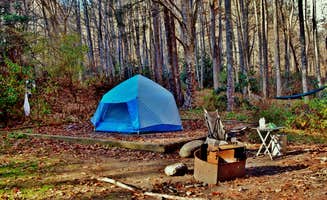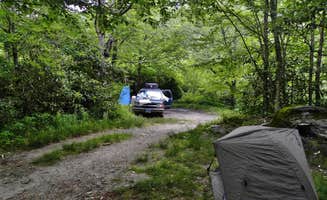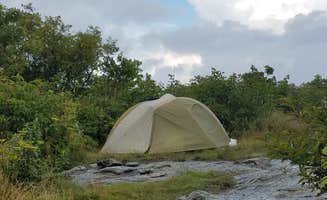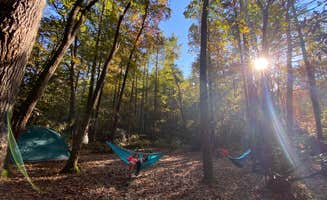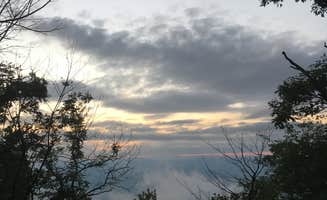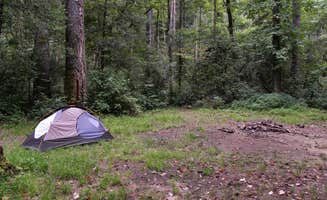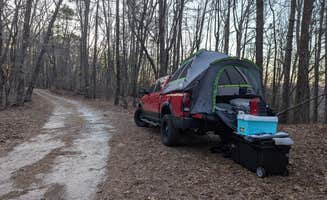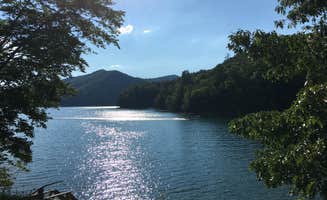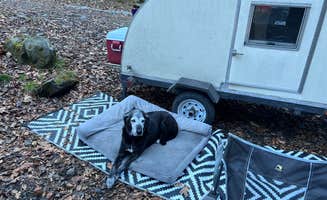Dispersed camping sites near Cullowhee, North Carolina are scattered throughout Pisgah National Forest at elevations ranging from 2,000 to 6,000 feet, creating variable temperatures even in summer months. Free camping areas typically follow the 14-day stay limit enforced by U.S. Forest Service rangers, who have increased patrols in popular areas. Camping is prohibited within 150 feet of any water source to protect local watersheds.
What to do
Waterfall exploring: 5 miles from campsites. Near Glen Falls Backcountry Campground, the main trail offers multiple waterfall views. "The hike down from the upper trailhead is relatively steep and involves going down many (many) stairs but is well worth it for the views of Glen Falls," noted a camper who added that "most people do not make it all the way down to this site so you will most likely find a significant amount of privacy."
Creek swimming: No entry fee required. Upper Cove Creek campsites provide access to water features. One visitor described "Beautiful waterfall (whaleback falls I think?) just a quick 15 minute walk across the river and up the trail (follow Daniel ridge trail loop from parking lot). Not much free fall action for nature bathers, though there is enough water flow to lean in and get all that grease out of your hair!"
Mountain summit hikes: 30-minute trek from camp. The terrain offers moderate to strenuous hikes with significant elevation gain. A camper at Blue Ridge Roadside Campsites reported, "The Flat Laurel Creek Trail starts at these campsites and goes to Sam Knob, which is a 6,000 foot peak. You can also hike to Little Sam Knob at 5,862 feet."
What campers like
Solitude on weekdays: Sites fill quickly on weekends. The more remote locations offer privacy that many visitors value. At Blue Valley Dispersed Camping, campers appreciate the spacing between sites: "8 very well kept campsites. Almost all near a creek of some sort. Hiking trails near by. No facilities. Room for larger groups ~40 people max for the biggest site ~6 for the smallest."
Natural sound barriers: Creek noise masks nearby campers. When sites are full, running water helps maintain a sense of privacy. One camper at Blue Ridge Roadside noted, "Even if people are camping near you the stream creates a nice sound barrier so you don't really hear them. Very nice to fall asleep to the sound of the stream."
Easy trail access: No shuttle needed. Whiterock Gap Backcountry Campsite connects directly to longer trails. "This section of trail is part of the Bartram trail which is a wonderful through hike starting at the border with Georgia and traveling all the way up through Franklin and ending at Cheoah Bald and Stecoah Gap."
What you should know
Navigation challenges: GPS often fails. Several campers reported difficulty locating sites without paper maps. One visitor to Blue Valley warned, "Never found this place but it's definitely not where the map brings you. Beware." Another mentioned, "Spent 20 minutes trying to find this campground from where the GPS took us. Never found it."
Road conditions vary: Some sites require high clearance. Free camping near Cullowhee often means rough access roads. A camper at Blue Ridge Roadside Campsites noted, "The short couple yards dirt road entrance to the campsite had a couple big pot holes that requires accurate driving around."
Enforcement of distance rules: Rangers check regularly. At Black Balsam Knob, rangers actively enforce regulations: "You MUST camp outside of 1000ft from road. You WILL get investigated by park Rangers, which stepped up enforcement of this stupid, pointless law around 2 years ago."
Weather extremes: Prepare for rapid changes. Temperature swings can be drastic at higher elevations. Even in summer, one camper reported, "I went in July and it was cool in day and cold at night nice, secluded."
Tips for camping with families
Choose sites with natural boundaries: Safety for children. Campsites bordered by shallow water features keep kids contained. One family at 475b found that the "Little runoff creates a creek that is nice to listen to but only deep enough to get feet in."
Consider noise factors: Road proximity matters. Some otherwise excellent sites suffer from traffic noise. A camper noted about Blue Ridge Roadside Campsites: "The only downfall is the closeness to the highway, which can be noisy until later when the traffic slows down."
Check site security: Day hiker traffic. Sites near popular trailheads experience significant foot traffic. One camper reported: "I stayed for 2 nights and my stuff wasn't messed with when i was gone hiking even though there's a lot of foot traffic during the day."
Tips for RVers
Length restrictions: Most roads limit size. Free camping near Cullowhee typically accommodates smaller vehicles. At Whiterock Mountain Backcountry Campsite, a visitor noted the limitations: "This site is located at the top of a small peak a short way off of the main Whiterock Mountain Trail" making it impossible for RVs.
Limited turning radius: Scout ahead. Several forest roads have tight switchbacks or limited turnaround areas. One Upper Cove Creek camper specified: "Not for big rigs, RVs, etc. It's a tent or as I use the tree tent."
Entrance challenges: Watch for rock formations. Several sites have narrow access points with obstacles. A visitor to Blue Valley advised: "When I arrived the pavement ended and continued onward a very primitive gravel road. Pretty rough in some places and very narrow, let's just say I wouldn't want to end up encountering another car."


